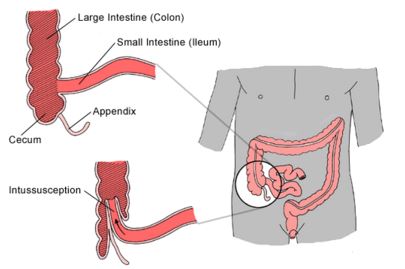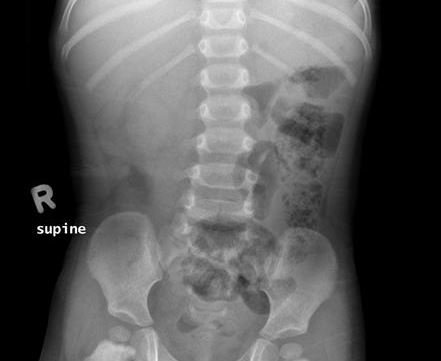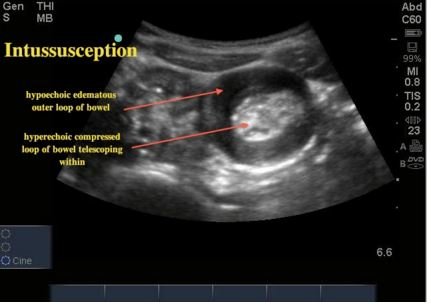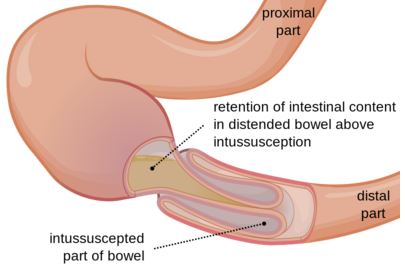Intussusception
What is intussusception?
Intussusception is a life threatening condition where the intestine is descending into an adjoining part. This sliding usually obstructs the gastrointestinal tract motility and resultant solid and liquid food content cannot pass through.
The sliding occurs due to part of the intestine prolapsed within another adjacent fold of intestine, which increases the pressure inside the intestinal wall and leads to inflammation. The affected parts get blood circulation obstruction.

Image 1: Anatomical description of Intussusception
In progressive condition, the intestinal tissue become perforated, infected and necrosis occur. The reported case history showed children less than 3 years, mostly affected by this disease rather than adult aged people.
The reason of development of intussusception in children is not yet discovered. Doctors reported that underlying cause for adult aged individuals are intestinal tumour.
Symptoms & Signs
The following symptoms often observed in case of intussusception:
- Frequent Vomiting
- Severe abdominal spasm or colic pain. Child is continuously crying for a long period and the leg is drawing upward direction
- Child facial expression becomes pale
- Child used to get fatigued
- Loose motion is often reported
- Diarrhoea is prominent
- Blood or mucus secretion may occur with stool
- Red jelly like stool pass is common in advanced stage
- Respiratory distress may occur
Doctors often get the following sign if intussusception is developed:
- Abdominal lump – Cylindrical shaped mass often developed in right upper quadrant (RUQ) of the abdomen or at the rear of the umbilicus or at the crossing of central line in epigastrium. The following findings are mostly common in the children:
- Often blood is present with stool
- Per rectum blood or Per Rectum mass may develop in some cases
- Paleness and sluggishness
- Inflated abdomen in advanced stage
- Severe bowel obstacle
- Hypovolaemia and shock is a progressive sign
Diagnosis (Ultrasound)
Doctors recommend doing some confirmatory laboratory tests which help to diagnose intussusceptions correctly. These diagnostic tools are:
- Abdominal X-Ray
- Fluoroscopy – contrast enema
- Computerized tomography (CT) scan
- Ultrasonography
Among all these tests ultrasonography is very commonly conducted for almost every case, as it is trustworthy diagnostic tool and rarely generate false or negative results. Relatively this screening test is cost effective rather than other test. In case of children the probability of risk is less potent and easily approachable.

The following ultrasonography indications are included in intussusceptions:
- Doughnut sign (Target sign): The manifestation is produced by concentric irregular echogenic and hypoechogenic posses. The echogenic posses are generated by mucosa and muscularis while the submucosa is accountable for the hypoechoic posses.
- Psedukidney sign: Longitudinal appearance of the intussuscepted subdivision of intestine in ultrasonography indicates this sign. The plump including mesentary which is drawn into the intussusception, enclosed vessels, is significant of the kidney hilum which is produced by the oedematous intestine.
- Crescent in a doughnut sign: The appearance of transverse ultrasonography indicates this sign. This appearance is developed due to intestinal intussusception and is an altered form of the doughnut sign (target sign)
. 
Image 3: Ultrasonography of Intussuception
Treatment
Intussusceptions treatment requires medical emergency care, as it leads to severe dehydration and shock. Continuous blockage of blood supply often leads to intestinal infection.
Early care
First and foremost duty of the doctors in case of intussusception is stabilization of the patient condition which can be achieved by
- IV infusion
- Reduction of intestines decompress by nasogastric tube insertion. In this technique, the catheter is inserted into the nose and extends up to the stomach.
Management
Doctors usually recommend to correct the intussusception are
- Barium or air enema. This comprises both investigation and treatment procedure. Barium enema or air enema is often effective for children and rarely used for adult patients. At initial application can cure 15-20% and repetition of the technique help to give effective result. It is essential for confirmation of the affectivity of this therapy, as it is not potential for every case.
- Surgical procedure. If the enema is ineffective for managing the condition then surgery is the only option. Surgery is often recommended for adults and resection and corrects the deformity is considered as an effective treatment.
Complications
Intussusception is a condition which arises due to segment formation in the intestine. This segment is formed in the intestinal wall. It is associated with pulling of mesentry, blood vessels and nerves in distal segment. This ultimately causes firmness in the veins and swelling occurs in the adjoining area.
This leads to obstruction of passage of food and liquid and also reduces the blood circulation to the affected part of the bowel. The usual location for sliding is at the junction of small intestine convenes with large intestine (ileocolic region).
Increased firmness in the blood vessels causes hindrance of blood supply in the affected region of the intestine. Continuous obstacles in blood supply cause necrosis of tissues which leads to internal haemorrhages and gangrenous. In advancement of disease condition may causes to abdominal infection and shock.
Intussusception Picture

References
- http://www.medicinenet.com/intussusception/article.htm
- http://www.mayoclinic.org/diseases-conditions/intussusception/basics/definition/con-20026823
- http://radiopaedia.org/articles/intussusception
- http://www.rch.org.au/clinicalguide/guideline_index/Intussusception_Guideline/
